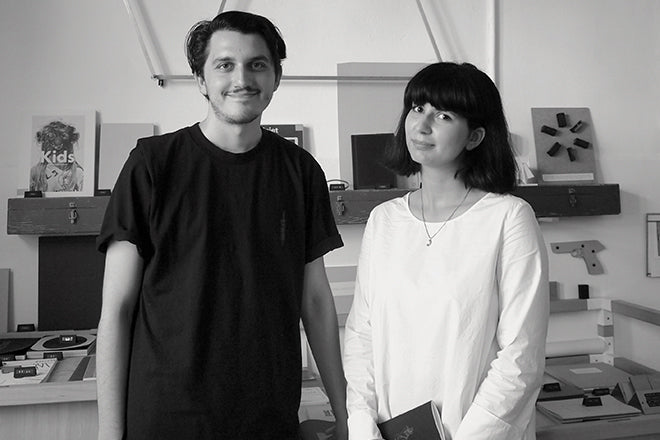
Petrica Mogos & Laura Naum, Kajet
This Monday we start the week with the team behind Kajet, who have just published the second issue of their Bucharest-based magazine. ‘Founding mother’ Laura Naum and ‘founding father’ Petrică Mogoș share their working week and their hopes for changing western perceptions of Romania.
Tell us about your typical Monday journey to work.
LAURA: We usually split our working schedule depending on the amount of work we have to get done. We go to the office if the workload is annoyingly heavy (as it is in most cases), but there are also times when we prefer to work from home.
PETRICA: Regardless, the typical Monday starts with one of us walking our little Dachshund (named Uli, above, whom we like to think of as our slacker intern), with the other making coffee. Some music in the background (anything that lies between Kamasi Washington and the always invigorating King Gizzard & the Lizard Wizard may help; it’s Monday after all), and we are good to go.
Describe the state of your desk and what you can see in your office.
PETRICA: Our home desk tends to get quite hectic and messy at times, we use it for nearly everything we do, from admin stuff to writing to hoarding and piling stuff that shouldn’t be there. The socialist blocks of flats that can be seen from our window mirror the Matisse and Malevich prints that we have been gradually sticking on the wall behind the desk. Together they sum up our publication quite well we think - some sort of hybrid middle ground, some kind of bridge between West and East.
LAURA: On the other hand, our office (above) has to be less cluttered as it’s in a shared space, in a location that we plan to transform into some sort of open-access atelier, comprising a micro-publishing house focused on Eastern European matters, an artbook/magshop, and a collective printmaking effort. More to come about this soon!
Which magazine do you first remember?
LAURA: Unfortunately, this has to be Bravo - a Romanian teens’ magazine that was at the epicentre of my 90s childhood and growing-up process. Very pop, not very hip, but quite fun: lots of gossip, lots of interviews, and charts, I definitely appreciated the interactive dimension of the magazine.
PETRICA: Same for me, I don’t think much was being done in terms of publishing for young kids, so the options were quite limited.
Which magazine matters to you the most right now?
LAURA: I tend to get inspired by many projects that happen globally, but if I were to choose some, I would definitely have to mention Vestoj for its ability to combine wit and information with accessibility without compromising rigor, and Dik Fagazine for its focus on marginalised or oppressed outcasts (as well as for an Eastern European kind of fraternity).
PETRICA:Archivio for its commitment to unearthing knowledge from the depths of the past, Flaneur for its level of experimentation with design and paper.
Can you describe your magazine in three words?
LAURA: The three Es: Eastern European Encounters.
Tell us about the independent magazine scene in Romania.
PETRICA: The local scene is still growing. A particularity of the scene would be that projects are more often than not initiated as one-off collaborations (which materialise into art books or zines or photo books). Recurrent publications, or publishing collectives, are less prolific.
LAURA: We’d like to change that. In this regard, besides the magazine, we are opening up our own publishing collective, to promote artists we like, to disseminate research that we find engaging, to talk about phenomena that happen locally but are of international interest.
Kajet seeks to educate readers about your part of our world. How have local readers and international readers responded?
PETRICA: Although we have accepted a tender form of self-colonisation by publishing in English (an aspect we always readily acknowledge), it does not mean that our Eastern European readership is less important; on the contrary, we assume a kind of responsibility and we have a clear ambition to be accepted by the Eastern European community.
LAURA: Even more so, we strive for a positive response, for Eastern Europeans to identify with our content, and for them to feel empowered & represented by our journal. If this is not the case, then perhaps the whole project becomes rather useless.
What did you learn from issue one that helped you improve and adapt issue two?
LAURA: First and foremost, we learned to trust our guts, to follow our instincts and personal taste. After all, to a certain extent, the magazine is a personal reflection and expression of ourselves. Much more than that, we became more aware of the balance between visual-written components: we realised that in this huge world of printed matter, you have to stand out somehow.
PETRICA: I totally agree. In our case we like to think that the chosen visual components work on an instinctual level of attraction, that they make potential readers interested in our project; at the same time, the written parts enhance knowledge and maintain a loyal readership.
What’s going to be the highlight of the week for you?
LAURA: We are anxiously waiting for some funding results for a project - an effort to digitise and archive Romanian publications issued between 1945-1989. This would be quite cool to actually happen, so fingers crossed!
PETRICA: Besides this, we are also working on some extra publications and on finishing up the structure of our third issue and in order to round it up we are going on a photo-trip in our neighbourhood.
What will you be doing after this chat?
LAURA: We’ll take Uli out for his noon walkie, dispatch some orders, and maybe -- why not -- treat ourselves with a nice pizza in the area.
Twitter: @kajetjournal













